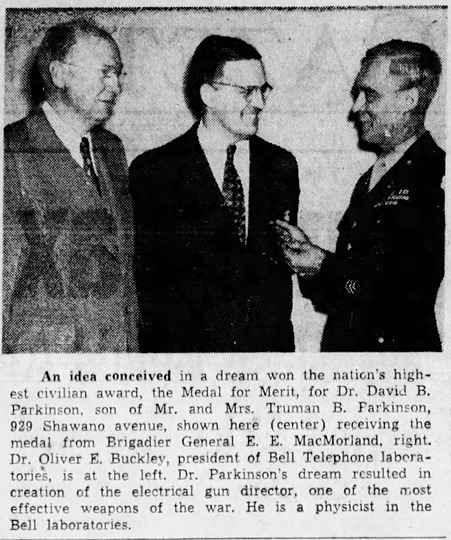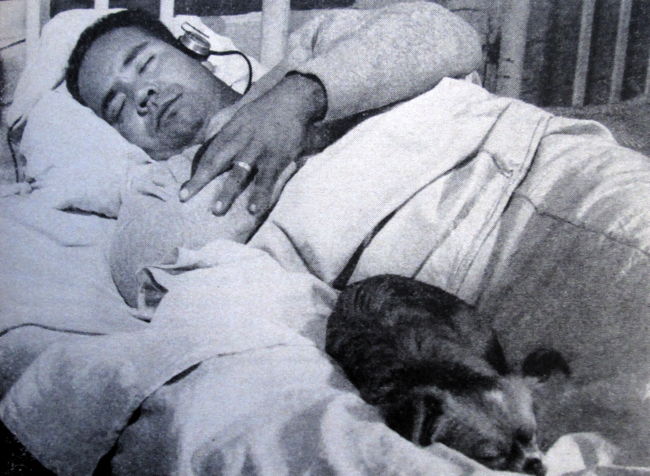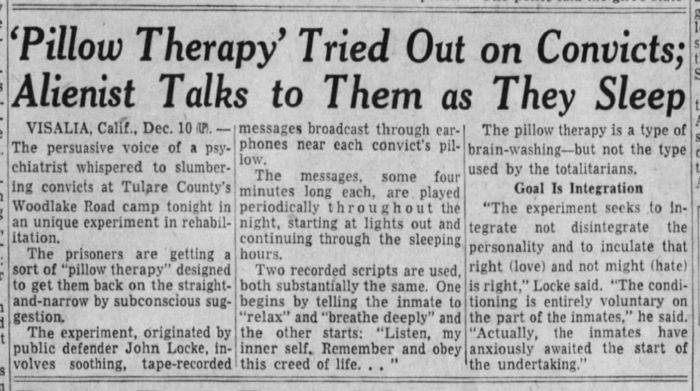Sleep and Dreams
By the Light of the Silvery Moon

Source: The Escanaba Daily Press (Escanaba, Michigan) 30 Jun 1953, Tue Page 8
Posted By: Paul - Wed Aug 11, 2021 -
Comments (0)
Category: Public Humiliation, Sleep and Dreams, Public Indecency, 1950s
Staying awake at the wheel
Over the years, inventors have dreamed up a variety of ways to keep drivers awake while driving.In 1936, Carl Brown got a patent on a chin-operated alarm device. If a driver started to nod off, and his head fell forward, this would depress a trigger, setting off an electric bell that would wake him up. (Patent No. 2,066,092)

In 1940, Raymond Young had the idea that whenever a driver was feeling drowsy he could press a button on the steering wheel and this would squirt an aromatic spray in his face, waking him up. (Patent No. 2,199,060)

And just last month, Hyundai was granted a patent for a system that shoots ultrasonic beams at a driver's eyes when it senses he's falling asleep. (Patent No. 11007932)

Posted By: Alex - Mon Jun 14, 2021 -
Comments (3)
Category: Inventions, Patents, Sleep and Dreams, Cars
Breath Deflector
In case your bed partner has bad breath.Patented in 1922 by Darwin Comings of Scranton, Pennsylvania.

Posted By: Alex - Sun Mar 07, 2021 -
Comments (0)
Category: Furniture, Inventions, Patents, Sleep and Dreams, 1920s, Smells and Odors
The Snore Consumer
I've come across reports in early 20th-century newspapers of an invention, designed to stop snoring, that worked by directing the sounds of the snoring into the snorer's own ear.
Oakland Tribune - Nov 26, 1933
I'm not sure if anyone ever really built this device, or if it was just a joke repeated by reporters.
The earliest report of it I've been able to find ran in newspapers in 1871. It attributed its invention to an unnamed woman from Iowa. However, I haven't been able to find a record of anything resembling this in the U.S. Patent Office, although there are numerous patents for anti-snoring devices.

Atchison Daily Champion - Feb 24, 1871
Posted By: Alex - Thu Feb 25, 2021 -
Comments (0)
Category: Inventions, Patents, Sleep and Dreams, Nineteenth Century, Cacophony, Dissonance, White Noise and Other Sonic Assaults
Comforting Hand Pillow
Madeline Robertson was recently granted a patent for a pillow with a foam hand sewn onto it. She explains that the hand (or 'tactile object,' as she refers to it) "provides tactile sensory feedback to the user designed to comfort the user."It reminds me of that robotic hand for people who have no one to hold their hand on walks we recently posted about.
Patent No. 10806281: Substrate having a therapeutic tactile object attached

Posted By: Alex - Mon Nov 30, 2020 -
Comments (0)
Category: Inventions, Patents, Sleep and Dreams
Beauty Pillow
Patent No. 2,533,526 was granted to Yvonne Bersia Snyder of Forest Hills, NY for a "Beauty Pillow":During sleep the tissues of the face are usually crushed or folded in the same position for hours at a time. For example, the flesh of the cheeks or face when flattened against the pillow during the sleeping hours pushes the skin forwards and settles in the hollows of the eyes where it produces wrinkles.
It is an object of this invention to prevent wrinkles or damaging of the skin tissues during rest.
Looks like it could also double as headgear for full-contact sports.

Posted By: Alex - Sun Nov 15, 2020 -
Comments (3)
Category: Beauty, Ugliness and Other Aesthetic Issues, Inventions, Patents, Sleep and Dreams, 1950s
Sleep Robot
Posted By: Paul - Mon Nov 09, 2020 -
Comments (0)
Category: Anthropomorphism, Inventions, Sleep and Dreams, Europe
Parkinson’s Dream Weapon
How, in 1940, a Bell Labs engineer invented a guidance system for anti-aircraft guns in a dream. Source: The Bigelow SocietyA compelling example in favour of this theory concerns an engineer, David Bigelow Parkinson. The time was spring, 1940 and Parkinson was then a young engineer working at Bell Telephone Laboratories in New York City in the specialized field of electromechanical design. He was working on improving an instrument called an automatic level recorder. A small potentiometer [an instrument for measuring electromotive forces] controlled a pair of magnetic clutches which in turn controlled a pen to plot a logarithm.
Meanwhile, the top story in the headlines concerned the evacuation of hundreds of thousands of stranded Allied soldiers from the beaches of Dunkirk, France across the Channel to England. This news greatly preoccupied Parkinson's mind along with that of his work. And the two ideas came together in a dream, which he later described in an unpublished memoir:
I found myself in a gun pit or revetment with an anti-aircraft gun crew . [A] gun there. was firing occasionally, and the impressive thing was that every shot brought down an airplane! After three or four shots one of the men in the crew smiled at me and beckoned me to come closer to the gun. When I drew near he pointed to the exposed end of the left trunnion. Mounted there was the control potentiometer of my level recorder!
Parkinson realized the full significance of his dream the following morning. If his potentiometer could control the pen on the recorder, something similar could, with the right engineering, control an anti-aircraft gun. At the time, the complex mechanical systems controlling these guns were not very accurate and could not be mass-produced.
Parkinson discussed the idea that morning with his boss, Clarence A. Lovell. They worked for several days writing a report and then met with Lovell's boss. Just before this meeting, on 18 June 1940, Parkinson realized he would need a diagram to explain his ideas so made a quick sketch on a sheet of plain white typingpaper.
The company submitted a proposal for exploratory work on an electromechanical system for directing antiaircraft guns to the Army Signal Corps which was subsequently approved. An engineering model was delivered for testing to the Army at Fort Monroe MD on 1 December 1941. The result of Parkinson's dream began rolling off the assembly lines early in 1943. More than 3000 of the gun directors, designated the M-9, were built.
Many thousands of shells were fired to bring down a single aircraft with the older directors; the M9 brought the number down to around 100 shells per hit on an aircraft.
Thus Parkinson's unconscious revelation led to one of the most effective pieces of air-defense technology in World War II.

Green Bay Press Gazette - Apr 22, 1947
Posted By: Alex - Thu Oct 08, 2020 -
Comments (3)
Category: Sleep and Dreams, 1940s, Weapons
The Sleepwalking Bandsman
— Hilary Evans, "The Sleepwalking Bandsman," The Skeptic, 16(2), Winter 2004.

The nighttime walk of a sleepwalking trombone player on the roof of his house in Hettstadt, Germany.
Posted By: Alex - Sat Sep 26, 2020 -
Comments (3)
Category: Sleep and Dreams, 1930s
Operation Sleep

In 1957, the Woodlake road camp prison in California began an experiment in convict rehabilitation. It was called "Operation Sleep." The idea was to use sleep learning to reform convicts. As the prisoners slept, they heard the soothing voice of a psychiatrist speaking the following script:
I am truly happy. I give my life to my family, to my friends, and to the world. I am filled with love and compassion for all, so help me God.
The script had been written by the County's Public Defender, John Locke, with help from a local Presbyterian minister, Rev. Glen Peters, and a hospital therapist, Robert C. Lally. They described Operation Sleep as "a type of brain-washing — but not the type used by the totalitarians."
Unfortunately, there doesn't seem to be any data on whether the experiment actually had an effect of criminal behavior. The superintendent of the prison noted, "We have had excellent cooperation from the inmates. But of course, it is too early yet to tell what effect it will have. We won't know until after the men have been released and face the temptations of freedom again."
The picture at the top is from Newsweek (Dec 30, 1957), and shows one of the prisoners who participated in the experiment. The fact that he's sleeping with a dog seems a little strange. I guess the inmates got to keep pets in this prison.

Wilmington Morning News - Oct 11, 1957
Update: I found a news story from 1961 offering a 3-year update on Operation Sleep. I'm actually surprised that the prison kept the experiment going for that long. Public defender John Locke claimed that the experiment had been showing positive results, but said they needed to keep it going for another 3 years to be sure. From the Ottawa Citizen - Feb 21, 1961:
Almost from the beginning though, the guards at the road camps noticed that the young inmates did not cause the same amount of trouble they had created formerly and were surprised when prisoners started coming to them for counsel.
What is probably most indicative of the therapy's effect is the decrease in alcoholism revealed by surveys among ex-prisoners.
Posted By: Alex - Mon Sep 26, 2016 -
Comments (3)
Category: Prisons, Sleep and Dreams, 1950s

| Who We Are |
|---|
| Alex Boese Alex is the creator and curator of the Museum of Hoaxes. He's also the author of various weird, non-fiction, science-themed books such as Elephants on Acid and Psychedelic Apes. Paul Di Filippo Paul has been paid to put weird ideas into fictional form for over thirty years, in his career as a noted science fiction writer. He has recently begun blogging on many curious topics with three fellow writers at The Inferior 4+1. Contact Us |




